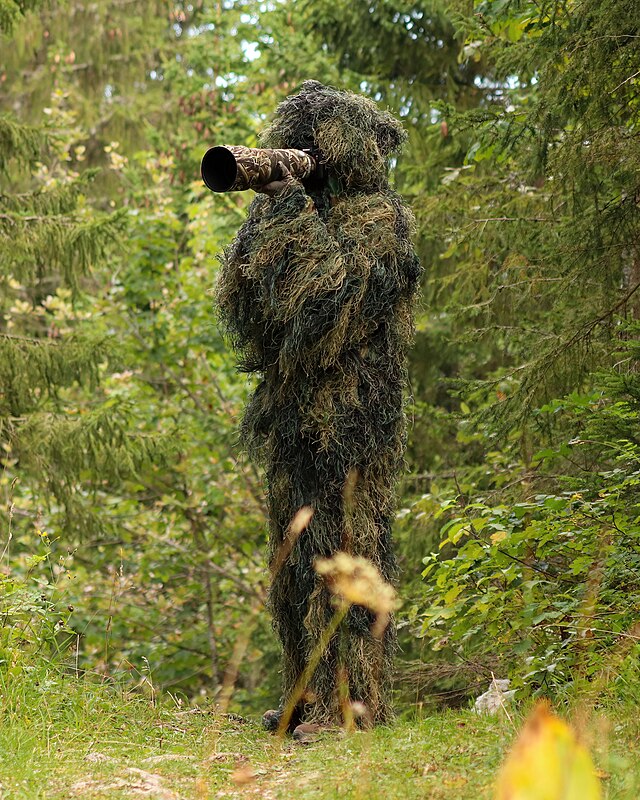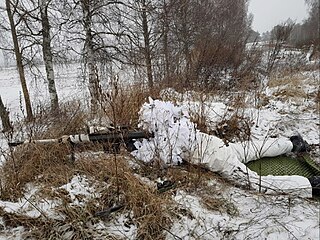Top Qs
Timeline
Chat
Perspective
Ghillie suit
Type of camouflage clothing From Wikipedia, the free encyclopedia
Remove ads
A ghillie suit[needs IPA] is a type of camouflage clothing designed to resemble the background environment – such as foliage. Typically, it is a net or cloth garment covered in loose strips of burlap (hessian), cloth, twine, or jute sometimes made to look like leaves and twigs, and optionally augmented with foliage from the area.



Military personnel, police, hunters, and nature photographers may wear a ghillie suit to blend into their surroundings and to conceal themselves from enemies or targets.[1] The suit gives the wearer's outline a three-dimensional breakup, rather than a linear one. When manufactured correctly, the suit will move in the wind in the same way as surrounding foliage. Some ghillie suits are made with light and breathable material that allows a person to wear a shirt underneath.

Hunters and soldiers may use ghillie suits with designs named for rural folk-spirits such as the kikimora of the swamps or the leshy of the forests.[2]
Remove ads
History
The English word ghillie is derived from the Scots Gaelic gille, meaning a young man or older boy who works as an outdoor servant, and is most familiar in reference to those employed to assist sportsmen with recreational shooting or fishing in the Highlands. The term ghillie suit may be a reference to the Ghillie Dhu, an earth spirit in Scottish mythology clothed in leaves and moss.[1]
The Lovat Scouts, a Scottish Highland regiment formed by Simon Fraser, 14th Lord Lovat during the Second Boer War, is the first known military unit to use ghillie suits and in 1916 went on to become the British Army's first sniper unit.[3][4] The Lovat Scouts were initially recruited from Scottish Highland estate workers, especially professional stalkers and gamekeepers.[5]
Similar sniper outfits in the Australian Army are nicknamed yowie suit, named for their resemblance to the yowie, a mythical hominid similar to the yeti and bigfoot which is said to live in the Australian wilderness.[6]
Remove ads
Technical and safety considerations
Summarize
Perspective
Although highly effective, conventional ghillie suits (made in fabric or 3D leafsuits) are impractical for many situations where camouflage is useful. They tend to be very heavy and hot. Even in moderate climates, the temperature inside the ghillie suit can reach over 50 °C (122 °F). The burlap is also flammable, unless treated with fire retardant, so the wearer may be at increased risk from ignition sources such as smoke grenades or white phosphorus. Moreover, conventional ghillie suits and 3D leafsuits are made using fabric, so they retain water, and this dramatically increases weight. Conventional ghillie suits are not designed to camouflage in the IR spectrum. Fabric strips, especially of coarse material like burlap, readily snag on thorns, twigs, and barbed wire.

To enhance safety, the US Army Soldier Systems Center has developed an inherently fire-resistant, self extinguishing fabric to replace jute or burlap. This material was field tested in late 2007 at the Sniper School at Fort Benning and has been standard issue since June 2008.
Ghillie suits also have disadvantages in cold environments, as they can get soaked, risking hypothermia.[7]
Remove ads
Criminal use
Civilians have, on rare occasions, purchased ghillie suits to commit violent crimes (other than unlawful hunting). In 2017, an Australian man was arrested after having committed sexual assault while wearing a ghillie suit.[8]
References
Further reading
External links
Wikiwand - on
Seamless Wikipedia browsing. On steroids.
Remove ads
